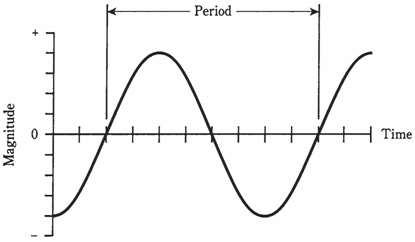Period and frequency:
In the periodic alternating current wave, the kind which is discussed in this topic, the function of magnitude versus time repeats itself again and again, such that the same pattern recurs countless times. The length of time among one repetition of the pattern, or one cycle, and the next is called as period of the wave. This can be illustrated as seen in the figure given below in simple ac wave. The period of a wave can, theoretically be anywhere from the minuscule fraction of the second to many centuries. Radio frequency currents reverse polarity millions or billions of times per second. The charged particles held captive by magnetic field of the sun, and also by the much larger magnetic fields around galaxies, may alter their direction over periods measured in thousands or millions of years. Period, when measured in the seconds, can be denoted by T.

Figure-- A sine wave. The period is the length of time for one complete cycle.
The frequency, denoted f, of a wave is the reciprocal of the period. That is, f = 1/T and T = 1/f .Originally, frequency was specified in cycles per second, abbreviated cps. High frequencies were at times given in kilocycles, megacycles, or gigacycles, representing thousands, millions, or billions of cycles every second. But thesedays, the unit is called as the hertz, abbreviated Hz. Hence, 1 Hz = 1 cps, 10 Hz = 10 cps, and so on.
Higher frequencies can be given in kilohertz), megahertz), or gigahertz. The relationships are:
1 kHz = 1000 Hz
1 MHz = 1000 kHz = 1,000,000 Hz
1 GHz = 1000 MHz = 1,000,000,000 Hz
At times an even bigger unit, terahertz (THz), is required. This is a trillion (1,000,000,000,000) Hz. Electrical currents do not attain such frequencies generally, although electromagnetic radiation can.
Some alternating current waves have only one frequency. These waves are generally called as pure. But often, there are components at the multiples of the main, or fundamental, frequency. There may be components at the odd frequencies. Some alternating current waves are extremely complex, comprising of hundreds, thousands, or infinitely many different component, frequencies.